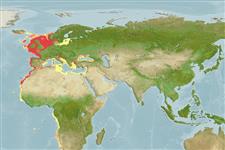Common names from other countries
Environment: milieu / climate zone / depth range / distribution range
Ecologia
marino demersale; distribuzione batimetrica 5 - 450 m (Ref. 35388), usually 10 - 40 m (Ref. 4710). Subtropical; 66°N - 21°N, 28°W - 41°E
Eastern Atlantic: Iceland and Scotland southward, also North Sea, Kattegat and Baltic; Mediterranean Sea: including Adriatic, Sea of Marmara, Bosporus.
Length at first maturity / Size / Peso / Age
Maturity: Lm 7.9, range 7 - 8 cm
Max length : 20.0 cm TL maschio/sesso non determinato; (Ref. 88088); common length : 8.0 cm TL maschio/sesso non determinato; (Ref. 3397); peso massimo pubblicato: 53.28 g (Ref. 88088); Età massima riportata: 13 anni (Ref. 32766)
Spine dorsali (totale) : 0; Raggi dorsali molli (totale) : 65 - 78; Raggi anali molli: 49 - 63. Anterior nostril on blind side not enlarged, anterior nostril on eyed side with a backward-pointing tube, reaching to vertical through front margin of lower eye. Pectoral fins on blind side reduced to a single long and 1-2 short fin rays. The supra-temporal branch of lateral lie without tubular scales. Vertebrae 36-38. Scales rectangular, intercanalicular striae strongly curved.
Demersal on sandy bottoms of continental shelf and slope. Feeds on a wide range of bottom-living organisms, mainly crustaceans (copepods, amphipods, cumaceans), bivalve mollusks, and polychaetes (Ref. 3397).
Bauchot, M.-L., 1987. Poissons osseux. p. 891-1421. In W. Fischer, M.L. Bauchot and M. Schneider (eds.) Fiches FAO d'identification pour les besoins de la pêche. (rev. 1). Méditerranée et mer Noire. Zone de pêche 37. Vol. II. Commission des Communautés Européennes and FAO, Rome. (Ref. 3397)
IUCN Red List Status (Ref. 130435)
CITES (Ref. 128078)
Not Evaluated
Threat to humans
Harmless
Human uses
Pesca: scarso interesse commerciale
Strumenti
Special reports
Download XML
Fonti Internet
Estimates based on models
Preferred temperature (Ref.
115969): 8.1 - 18.8, mean 10.6 (based on 734 cells).
Phylogenetic diversity index (Ref.
82804): PD
50 = 1.0000 [Uniqueness, from 0.5 = low to 2.0 = high].
Bayesian length-weight: a=0.00851 (0.00716 - 0.01011), b=3.05 (3.00 - 3.10), in cm Total Length, based on LWR estimates for this species (Ref.
93245).
Trophic level (Ref.
69278): 3.3 ±0.4 se; based on diet studies.
Resilienza (Ref.
120179): Medio, tempo minimo di raddoppiamento della popolazione 1.4 - 4.4 anni (K=0.54-0.61; tm=3; tmax=13).
Fishing Vulnerability (Ref.
59153): Low vulnerability (24 of 100).
